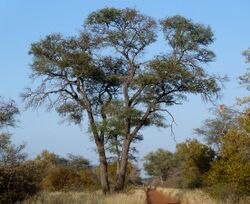Biology:Senegalia nigrescens
From HandWiki
Short description: Species of legume
| Senegalia nigrescens | |
|---|---|

| |
| In Limpopo, South Africa | |
| Scientific classification | |
| Kingdom: | Plantae |
| Clade: | Tracheophytes |
| Clade: | Angiosperms |
| Clade: | Eudicots |
| Clade: | Rosids |
| Order: | Fabales |
| Family: | Fabaceae |
| Subfamily: | Caesalpinioideae |
| Clade: | Mimosoid clade |
| Genus: | Senegalia |
| Species: | S. nigrescens
|
| Binomial name | |
| Senegalia nigrescens (Oliv.) P.J.H.Hurter
| |
| Synonyms | |
| |
Senegalia nigrescens, the knobthorn, is a deciduous African tree, growing up to 18 m tall,[1] that is found in savanna regions from West Africa to South Africa. The tree is resistant to drought, not resistant to frost and its hard wood is resistant to termites.[1]
Ecology
Giraffes often browse on the flowers and foliage of this tree, while the seed pods and foliage are browsed on by a range of mammals, including elephants.[2]
Uses
An ointment made from the roots has traditionally been used to treat convulsions.[3]
Gallery
-
compound leaves
-
flower spike
-
rufous seed pods
-
knobbly bark
References
- ↑ 1.0 1.1 Masupa, Thabo. "Senegalia nigrescens (as Acacia nigrescens)". PlantZAfrica.com. National Herbarium, Pretoria. http://www.plantzafrica.com/plantab/acacianigrescens.htm. Retrieved 7 October 2012.
- ↑ Van Wyk, Piet (2008). Field guide to the TREES of the Kruger National Park. Cape Town: Struik. p. 69. ISBN 978-1-77007-759-1.
- ↑ Cumes, David (2009). Healing trees & plants of the Lowveld. Rael Loon, Dries Bester. Cape Town, South Africa: Struik Nature. ISBN 978-1-77007-833-8. OCLC 506229195. https://www.worldcat.org/oclc/506229195.
External links
Wikidata ☰ Q3643159 entry
 |





